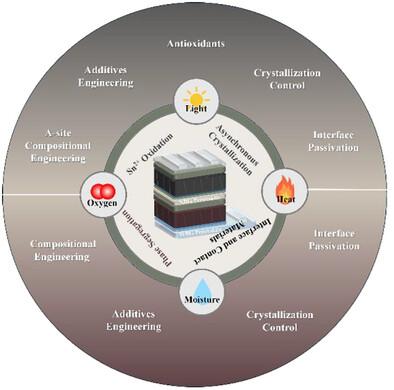Stability Challenges and Solutions in Wide‐ and Narrow‐Bandgap Perovskites for All‐Perovskite Tandem Solar Cells
IF 26
1区 材料科学
Q1 CHEMISTRY, PHYSICAL
引用次数: 0
Abstract
Perovskites possess exceptional optoelectronic properties, including tunable direct bandgaps and long carrier diffusion lengths that render ideal absorbers for tandem solar cell architectures. In all‐perovskite tandem solar cells (APTSCs), the integration of wide‐bandgap (WBG) and narrow‐bandgap (NBG) sub‐cells enables more efficient harvesting of the solar spectrum, leading to certified power conversion efficiencies (PCEs) as high as 30.1%. Despite this progress, ensuring long‐term operational stability remains a major challenge. WBG perovskites are prone to photo‐induced phase segregation and the formation of deep‐level defects, whereas NBG perovskites are vulnerable to Sn

全钙钛矿串联太阳能电池宽带隙和窄带隙钙钛矿的稳定性挑战和解决方案
钙钛矿具有优异的光电性能,包括可调的直接带隙和较长的载流子扩散长度,是串联太阳能电池结构的理想吸收剂。在全钙钛矿串联太阳能电池(aptsc)中,宽带隙(WBG)和窄带隙(NBG)子电池的集成能够更有效地收集太阳光谱,从而使经认证的功率转换效率(pce)高达30.1%。尽管取得了这些进展,但确保长期运行的稳定性仍然是一个重大挑战。WBG钙钛矿容易发生光诱导的相偏析和深层缺陷的形成,而NBG钙钛矿容易发生Sn2 +氧化和基于异步结晶的缺陷。这些内在的不稳定性,再加上光、热、湿、氧等外部压力,在实际操作条件下加速了性能的退化。因此,实现持久的APTSCs需要全面了解影响WBG和NBG吸收剂的降解机制。这篇综述系统地探讨了WBG和NBG钙钛矿的内在和外在降解途径,特别强调了界面、电荷选择层和环境条件的作用。此外,我们总结了旨在提高aptsc稳定性的缓解策略的最新进展。
本文章由计算机程序翻译,如有差异,请以英文原文为准。
求助全文
约1分钟内获得全文
求助全文
来源期刊

Advanced Energy Materials
CHEMISTRY, PHYSICAL-ENERGY & FUELS
CiteScore
41.90
自引率
4.00%
发文量
889
审稿时长
1.4 months
期刊介绍:
Established in 2011, Advanced Energy Materials is an international, interdisciplinary, English-language journal that focuses on materials used in energy harvesting, conversion, and storage. It is regarded as a top-quality journal alongside Advanced Materials, Advanced Functional Materials, and Small.
With a 2022 Impact Factor of 27.8, Advanced Energy Materials is considered a prime source for the best energy-related research. The journal covers a wide range of topics in energy-related research, including organic and inorganic photovoltaics, batteries and supercapacitors, fuel cells, hydrogen generation and storage, thermoelectrics, water splitting and photocatalysis, solar fuels and thermosolar power, magnetocalorics, and piezoelectronics.
The readership of Advanced Energy Materials includes materials scientists, chemists, physicists, and engineers in both academia and industry. The journal is indexed in various databases and collections, such as Advanced Technologies & Aerospace Database, FIZ Karlsruhe, INSPEC (IET), Science Citation Index Expanded, Technology Collection, and Web of Science, among others.
 求助内容:
求助内容: 应助结果提醒方式:
应助结果提醒方式:


